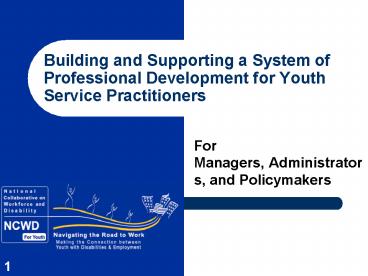For Managers, Administrators, and Policymakers - PowerPoint PPT Presentation
1 / 22
Title:
For Managers, Administrators, and Policymakers
Description:
Building and Supporting a System of Professional Development for Youth Service Practitioners ... supporting and strengthening professional development systems ... – PowerPoint PPT presentation
Number of Views:20
Avg rating:3.0/5.0
Title: For Managers, Administrators, and Policymakers
1
Building and Supporting a System of Professional
Development for Youth Service Practitioners
- For Managers, Administrators, and Policymakers
2
National Collaborative on Workforce and
Disability for Youth
- Strives to ensure that youth with disabilities
are provided full access to high quality services
in integrated settings in order to maximize their
opportunities for employment and independent
living. www.ncwd-youth.info - Funded by U.S. Department of Labor's Office of
Disability Employment Policy (ODEP).
3
Presenter Contact Information
- Curtis Richards
- Institute for Educational Leadership and the
National Collaborative on Workforce and
Disability for Youth (NCWD/Youth) - (202) 822-8405 richards_at_iel.org www.iel.org
- GeMar Neloms
- National Youth Employment Coalition
- (202) 659-1064 gn_at_nyec.org www.nyec.org
4
Workshop Objectives
- In this workshop, we will
- Provide an overview of the knowledge, skills and
abilities (KSAs) that youth service professionals
need to work most effectively with youth - Explore how the KSAs can inform the creation and
strengthening of effective professional
development systems - Examine strategies for supporting and
strengthening professional development systems
5
Survey of youth practitioners finds youth workers
- Feel least proficient in
- Conducting individualized assessment planning
- Designing and delivering programs
- Receive the least training in
- Building relationships with employers
- Connecting to community resources
- Conducting individualized assessment planning
6
Professional development for practitioners
benefits youth and society
Systematic high quality professional development
Increased practitioner satisfaction, retention
and skills
Increased economic independence and
self-sufficiency for youth
Improved youth outcomes
Improved practice
7
Professional development for practitioners is a
good investment
- Staff turnover can cost an organization 29-40 of
the positions salary when factoring for
recruiting, hiring, training and lost
productivity - Professional development can decrease staff
turnover by increasing practitioner job
satisfaction and confidence
8
Professional Development System Characteristics
- 1. The required knowledge, skills and abilities
(KSAs) of youth service practitioners in the
organization have been identified - 2. Job descriptions, recruiting, hiring and
training practices reflect these KSAs - 3. Program or process is in place and provides
support to oversee professional development
9
Professional Development System Characteristics
- 4. Staff have meaningful opportunities to
develop and practice new knowledge and skills - 5. Staff participate in identifying important
areas for professional development - 6. Staff have personalized development plans
- 7. There is a method to assess staff attainment
of required KSAs
10
Professional Development System Characteristics
- 8. Adequate time and resources are allocated to
professional development - 9. Professional development is provided in areas
of need and aligned with organizational mission
and goals - 10. Recognition of youth service practitioners
with relevant and adequate KSAs is consistent and
systematic
11
Serving ALL youth requires specialized knowledge
- 30-40 of youth in foster care attend special
education classes - 36 of high school dropouts have learning
disabilities and 59 have emotional or behavioral
disorders - 75 of youth in juvenile justice system have
some type of disability - See Why Professional Development? Info Brief
for source information
12
KSAs 10 Competency Areas
- Knowledge of the Field
- (theory, law, professional ethics)
- 2. Communication with Youth
- (respect, listening, diversity, advocacy)
13
KSAs 10 Competency Areas
- 3. Assessment Individual Planning
- (informed choice, tools, track progress)
- 4. Relationship to Family Community
- (engage family, connect to community)
14
KSAs 10 Competency Areas
- 5. Workforce Preparation
- (skill-building, coaching, job matching)
- 6. Career Exploration
- (tools, engage employers, market trends)
15
KSAs 10 Competency Areas
- 7. Relationships with Employers
- (recruit, engage, mediate, train, support)
- 8. Connection to Resources
- (identify, network, collaborate, market own)
16
KSAs 10 Competency Areas
- 9. Program Design Delivery
- (know systems, manage groups, evaluate)
- 10. Administrative Skills
- (referrals, team work, time management)
17
Youth Services Endorsement
- The National Association of Workforce Development
Professionals (NAWDP) offers a Certified
Workforce Development Credential (CWDP) - An additional specialty certification known as
the Youth Services Endorsement is based on the 10
KSAs - Information on the Youth Service Endorsement can
be found at www.nawdp.org
18
Professional Development System Road Map
- Assess Identify the strengths and gaps in the
KSAs of your organization - Plan Identify strategies, resources and outcomes
for professional development develop
professional development plans for the staff
and organization - Build
- Strengthen Provide formal and informal
professional development opportunities
19
KSA Tools and Resources
- KSA Assessment for Organizations and Systems
- KSA Assessment for Practitioners
- KSA Professional Development Plan for
Practitioners
20
Strategies to support professional development
- Building consensus
- Setting requirements
- Maximizing and blending funding streams
- Requiring professional development goals in RFPs
across systems - Providing opportunities and funding for training
21
Additional KSA Resources
- KSA Hot Topic (On-line, audience-specific pages)
- Why Professional Development? Info Brief
- KSA On-line Study Guide (with objectives,
activities, demonstration of learning
resources) See http//www.ncwd-youth.info/ksa/inde
x.html
22
Training Curricula and Other Initiatives for
Professional Development and Youth Work
- Global Career Development Facilitator
- http//www.cce-global.org/credentials-offered/gcd
fmain - Advancing Youth Development Curriculum
- http//nti.aed.org/Curriculum.html
- Next Generation Nonprofit Leaders Program
- www.humanics.org
- Council on Rehabilitation Education
- Disability and Rehabilitation Curriculum and
Rehabilitation Counselor Education Courses - http//www.core-rehab.org/

